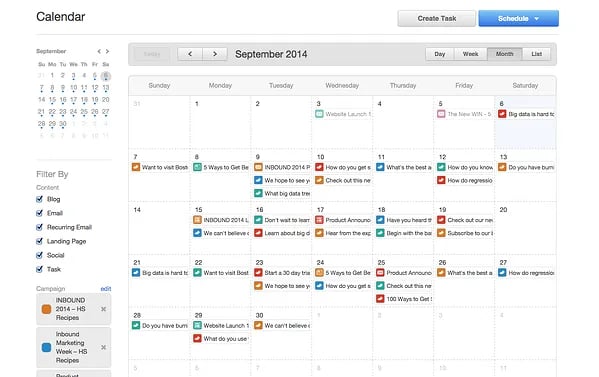The more you blog, the more traffic you drive to your site. In fact, companies that blog generate 55% more website visitors, 97% more inbound links, and 434% more indexed pages on average.

In order to create this blog content, blog editors need to spend a lot of time coordinating blog content which may involve recruiting writers, setting guidelines, and, of course, editing and publishing content. This is no easy task, but we are here to help you get started coordinating all that blog content. Here are the steps you need to take to schedule out your next month of blog post content -- take the same approach whether you're trying to schedule out a few days or weeks worth of content, or just coordinate long-term campaigns across multiple teams.
Step 1: Figure out your blog's goals.
First and foremost, think about why you're writing these posts -- what the blog's goals are. Are you trying to drive more traffic to your website? Generate leads? Educate your customers about a particular topic? Your goals can help you determine the type of content you want to focus on in the upcoming month.
For example, if your goals are around driving traffic to your site, you may think twice before making the majority of yours posts very analytical or technical. Instead, you may choose to focus on a list post that is easier for your audience to read and digest.
Step 2: Assess your resources.
You can't accurately plan a month's worth of blog posts without a full understanding of your resources. Ask yourself these questions:
- Do you have any budget? If so, how much?
- Do you have a team of dedicated writers internally that you can use?
- Do you have any external contributors or guest bloggers with whom you work?
- Do the writers you normally work with (internal or external) produce quality content?
- How much time do you personally have to write and edit?
- How much do you need to publish over the next month?
Once you answer these questions, you'll have a great idea of which resources you have at our disposal to help you plan for the upcoming month.
Step 3: Backlog some post ideas.
You won't be able to snap your fingers one day and immediately have enough blog posts in your queue to fill up a month. But you can make it a lot easier if you have some post ideas backlogged. Prepare for a month's worth of content by creating a backlog of content ideas to draw from. As much as we wish we can make content magically appear, the reality is, it takes a long time to create content -- and it's best to start early with a healthy backlog of ideas.
Step 4: Start allocating your resources.
Now that you've defined your blog's goals and assessed your resources, you can figure out how to allocate those resources. You'll want to keep your blog's goals top-of-mind during this exercise. For example, if you have goals around traffic, your resources should be allocated to create posts that drive traffic. If your goals are around lead generation, your resources should be allocated to create posts that you know convert your visitors into leads.
Now, look at your answers to the questions from the previous step, and think about how you can allocate the resources you have available. If you have some budget, for example, then you might consider hiring another writer -- even a freelance writer -- to contribute to your content backlog. If you already have a team of dedicated writers, you can help prepare to schedule all those blog posts by making sure writing blog posts become a big priority for them in the upcoming month. Figure out your personal schedule and how many posts you can commit to writing in the upcoming month, (keeping in mind that you might need to be editing some or all of those posts, too). Then, work backward to find out how many more posts you need from others to fill the rest of the open slots.
Step 5: Outline the contributor process.
Once you understand how many posts you need and who's going to write them, you should outline the logistics of your contributor process. This includes what you expect in each blog post, how far in advance of the publish date writers need to submit their posts, the steps writers need to take in order to submit a post, and so on.
The point of this step is setting expectations with all your blog contributors, which will save everyone time and stress in the long term. Here are a couple of logistics you should consider communicating:
Formatting Recommendations For Each Post Type
There are many types of blog posts: How-to posts, list posts, curated posts, visual posts, FAQ posts, newsjacks, thought leadership posts ... and so on. (Learn more about all the different post types here.)
You may know the ins and outs of each type of post, but your writers may not. Make their lives (and yours) easier by writing out guidelines for your contributors that helps explain exactly what you expect for each type of post. For example, with how-to posts you may want to include screenshots and specific, step-by-step instructions.
Editorial Guidelines
Anyone who has edited a blog post will know that formatting someone's content takes a lot of time. Give your blog contributors some guidelines so they can format some of the post, even if they don't get to all of it. This may include:
- Inserting header tags.
- Formatting images (size, image borders, etc.)
- Using bullet points vs. numbers for lists.
For more helpful ideas on what to include in your editorial guidelines, check out this article.
Instructions on Selecting a Call-to-Action
Every blog post should include a call-to-action -- it's the number one way to convert your readers into leads. It's up to you whether it's your job or your writers' to choose the call-to-action for their blog posts. If you want them to do it, then give them clear instructions for how to choose a call-to-action that relates to the blog post content. Also, ensure they know how to select one that has performed well historically -- and you probably know these analytics better than they do.
Step 6: Ask others in your company to write posts.
If you know there are other good writers in your company who could create good content, talk to members of the marketing team and other teams at your company. Whether someone's in sales, services, or support, they are interacting with the customer and may have good ideas of blog post content that could benefit your customer base. Go around your company and hear about these ideas from co-workers outside of the marketing team. You never know -- you could find your best writers hiding out in other departments.
Then, work with each individual to figure out the best type of content for them to write. If they are not comfortable writing a certain topic, don't force it. Once you find a topic, work with them on an outline to make sure they don't spend time writing something that won't be interesting to your audience. It may take some time upfront to onboard a guest contributor from your company, but once they get familiar with how to write for the blog, they might be more inclined to write posts in the future.
Also consider whether or not someone's strength is in writing or designing. If someone feels more comfortable designing than writing, there are still ways they can contribute to the blog. See if they want to create an infographic or visually recreate an evergreen blog post that performed well.
Step 7: Schedule out your content.
Once you have some great blog posts from your contributors, you're ready to schedule out your content. Based on what you discovered when you assessed your resources, plug in your content based how many posts you need on a daily or weekly basis.
You can schedule your content in an editorial calendar, like the new HubSpot Calendar. Using the HubSpot Calendar, you can schedule content, assign tasks, and organize all of your marketing assets including your blog, email, landing pages, and social messages.

You can choose to view your content with a day, week, month, or list view depending on your preference. You can also filter the content to view certain pieces of content at a time or different campaigns. If you click into any item on the calendar (which is color-coded based on your campaign, and given an icon based on the form of content), you will see more details about that piece of content.
To make your life easier, you'll want to use an editorial calendar that lets you assign tasks to co-workers and track their progress. (Customers: In HubSpot Calendar, if your task involves creating a blog post, email, or landing page, HubSpot will automatically create a draft form of that content for you. For example, if you create a blog post, the task tool will automatically map over your title, publish date, campaign, and topic tags. After you finish writing out your task, your colleague will receive an email letting them know that they have a task to complete.)
Once you schedule out your next month's worth of blog posts, you'll feel much more in control of your blogging strategy. Now -- time to get writing and editing!
What else do you do when you are scheduling out your blog posts?


![How Often Should You (or Your Company) Blog? [New Data]](https://blog.hubspot.com/hubfs/how%20often%20should%20you%20blog%20%28external%20research%29_featured.png)
![19 Types of Blogs that Make Money in 2024 [+Examples]](https://blog.hubspot.com/hubfs/blogs-Jan-05-2024-05-12-25-3281-PM.png)
![The Top 3 Reasons Consumers Read Blogs & How to Attract Them in 2024 [New Data]](https://blog.hubspot.com/hubfs/202_Reasons-Consumers-Read-Blogs.png)




